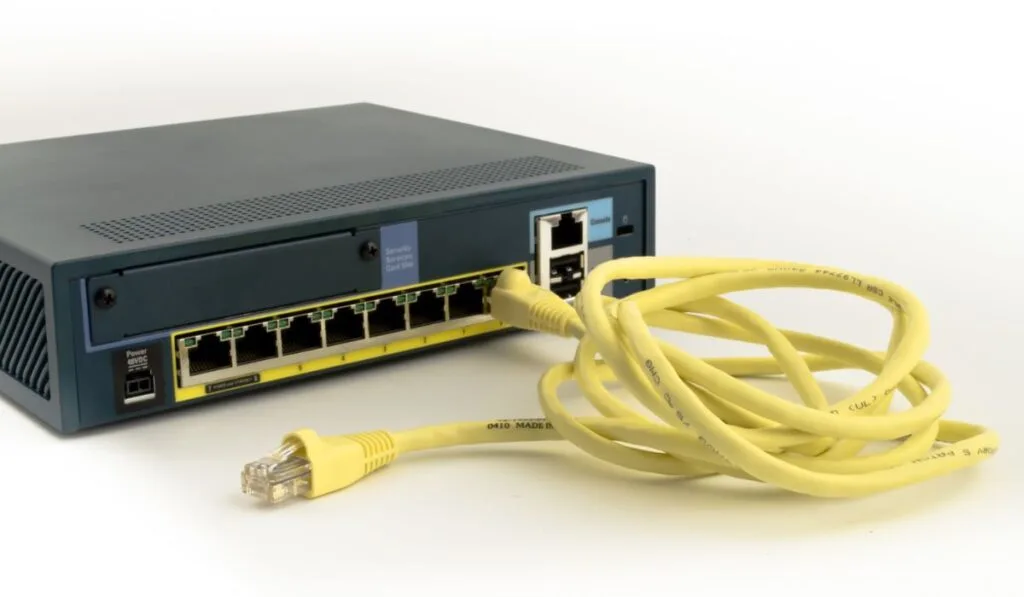The tech world is an incredibly complicated one that’s filled with terms and processes that many of us will never fully grasp. The ethernet internet connection is one of the tougher ones to understand. So, what exactly is it, and what do you need to know about ethernet?
An ethernet cable is a type of network cable that’s used for wired networks. It uses ethernet ports to connect devices on local area networks (LANs), such as PCs to a router or internet modem. Ethernet cables are fast and highly consistent.
Even in an era of WiFi, the ethernet connection is still crucial to many business and home environments. Let’s take a closer look at how it works and what it’s best used for.
What Is an Ethernet Cable and What Is It Used for?

An ethernet cable looks like a large traditional phone cable but with more wires — 8 compared to a phone’s 4. Most of the time, it’s used to physically connect a PC to a router, thereby providing internet access.
You need to plug your ethernet cable into an ethernet port. On your computer, this is found on the motherboard, usually accessible on the back or the side.
If your computer doesn’t have an ethernet port, you can use an ethernet cable with a USB adapter, like this one (on Amazon). Don’t unplug your ethernet cable while using it; otherwise, you’ll instantly be disconnected from the internet.
Luckily, the cables are designed to snap-in snugly to avoid getting pulled by accident.
An advantage of using an ethernet cable for internet is that it’s faster and more consistent. It’s generally not interrupted by weather, walls, or other objects, so a sudden drop in internet speed is rare — and the same can’t be said for WiFi.
Types of Ethernet Cables
There are different categories of ethernet cables:
Category 5e
Normally abbreviated as Cat5e, the fifth generation of twisted pair ethernet tech is the most popular type. This type consists of four pairs of copper wires and is normally restricted to a run length of 100 meters max. Cat5e cables (on Amazon) transmit fast internet speeds of up to 100 Mbps.
Category 6e
The sixth generation of twisted pair ethernet tech is commonly abbreviated to Cat6. Similar to Cat5e, these consist of four pairs of copper wires and are also limited to a run length of 100 meters max.
But unlike Cat5e, Cat6 (on Amazon) utilizes all four copper wirings and delivers speeds of up to 1 Gbps, twice as fast as Cat5e.
Category 7
Cat7s are similar to Cat6 cables but have higher shielding and better connectors. They’re also faster and offer speeds of up to 10 Gbps. The cables are yet to be approved by EIA and IEEE and are, therefore, less popular.
Categories 1 to 4 are outdated and rarely used. They are unshielded and super slow. Cat 4, for instance, offers speeds of 10 Mbps. Cat 8 cables have also been rolled out. They’re insanely fast (40 Gbps) but thick and can’t be installed in tight spaces.
How to Choose the Right Ethernet Cable
The next time you’re looking to purchase an ethernet cable, here are a few things to keep in mind.
Speed
Different types of ethernet cables have different speeds. If you have fast internet speeds — let’s say 1 Gbps — old cables will hold you back. Go for Cat6 or newer. 10 to 20 Mbps speeds are good with cat5 and older.
Distance
The farther you need to transmit internet using cables, the poorer your signal strength will be. Your internet connection will degrade and be distorted over longer distances, especially if the cable is unshielded.
Higher data speeds are attained over short distances. Ethernet cables normally have a maximum data rate of 328 ft. (100 m).
Shielding
An ethernet cable can either be shielded or unshielded. Shielded ethernet cables are normally wrapped in foil or braided wire to protect the cables. They’re more suited for outdoors or within walls where the interference is high. Unshielded cables are great for indoor and domestic use.
Is Ethernet or WiFi Better?

WiFi is an excellent alternative to ethernet cables. It doesn’t require lots of cable lying around since the internet connection is wireless. But cable internet is almost always faster than WiFi.
So, which of the two is better? The better choice depends on your environment and what you use your internet for.
Go for ethernet cables if you:
- Are a gamer and need insanely fast internet speeds with low latency.
- Want maximum security for your internet. Hacking into an ethernet connection is difficult.
- Want a simple internet connection that is equally easy to connect and troubleshoot.
WiFi is an excellent option for you if you:
- Don’t game and use the internet for basic browsing and teleconferencing.
- Don’t need insanely fast internet speeds — just something reliable.
- Are looking for a relatively affordable internet plan.
